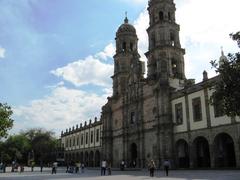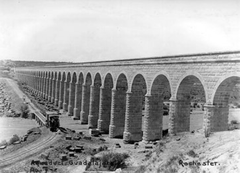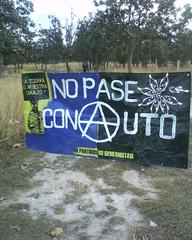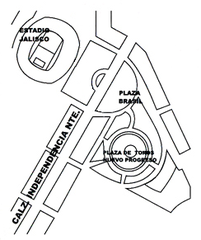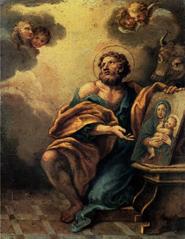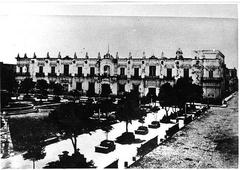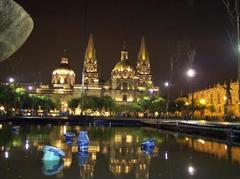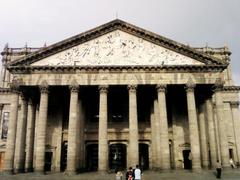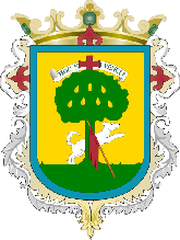Statue of Miguel de Ibarra, Guadalajara, Mexico: Visiting Hours, Tickets, and Historical Sites Guide
Date: 04/07/2025
Introduction: A Monument to Guadalajara’s Founding Spirit
Nestled in Plaza Fundadores at the heart of Guadalajara’s historic center, the Statue of Miguel de Ibarra stands as a tribute to one of the city’s most influential founders. As the first alcalde mayor (mayor) of Guadalajara at its current site since 1542, Ibarra’s legacy is deeply woven into the city’s colonial origins. The monument not only honors his leadership during turbulent times—including the Mixtón War and repeated relocations due to indigenous resistance—but also offers visitors a gateway to understanding the multicultural roots and enduring spirit of one of Mexico’s most significant cities (Indigenous Mexico; Guadalajara CC; Playas y Plazas).
Crafted by renowned sculptor Rafael Zamarripa and unveiled in 1959, the statue’s bronze figure symbolizes Ibarra’s vision and resilience. Its prominent setting, surrounded by other historic landmarks such as the Metropolitan Cathedral and Teatro Degollado, makes it a focal point for exploring Guadalajara’s colonial heritage. With 24/7 free access, wheelchair-friendly pathways, and a vibrant surrounding plaza, the site is welcoming to all visitors—whether history enthusiasts, art lovers, or casual tourists (Wikipedia; To Travel Too; Mexico Travel Blog).
This guide will explore Ibarra’s role in Guadalajara’s foundation, the historical context of the statue, practical visiting information, and tips for making the most of your visit to this iconic landmark. For further exploration, visitors can access virtual tours, interactive maps, and related events through local tourism resources and the Audiala app (Guadalajara Tourism; Lonely Planet).
Table of Contents
- Introduction: The Statue and Its Historical Significance
- Early Colonial Context and the Founding of Guadalajara
- Miguel de Ibarra: Life and Legacy
- The Founders and the Legacy of Guadalajara
- The Mixtón War and Indigenous Context
- Visiting the Statue: Practical Information
- Frequently Asked Questions (FAQs)
- Conclusion: Experience Guadalajara’s Colonial Heritage
- Additional Resources
Early Colonial Context and the Founding of Guadalajara
Founded four times between 1531 and 1542, Guadalajara’s establishment reflected the complexities of Spanish colonization and fierce indigenous resistance. Initially founded in Nochistlán, the city was relocated to Tonalá, Tlacotlán, and finally to its present site, as the Spanish sought safety and strategic advantage (Indigenous Mexico). The city’s name was chosen by Nuño de Guzmán to honor his Spanish hometown.
The current location was surrounded by indigenous settlements—including Mezquitán, Tetlán, and Mexicaltzingo—whose inhabitants played pivotal roles during conflicts like the Mixtón War (1540–1542), a major indigenous uprising against Spanish rule.
Miguel de Ibarra: Life, Role, and the Statue
Miguel de Ibarra, a Basque conquistador related to Francisco and Diego de Ibarra, was integral to Guadalajara’s foundation. He served as a regidor (councilman) and distinguished himself during the Mixtón War, defending the Spanish settlement from indigenous attacks. Ibarra was appointed captain and regidor in February 1542 and became the first alcalde mayor of the city at its present site shortly thereafter (Guadalajara CC).
The bronze statue by Rafael Zamarripa, located in Plaza Fundadores, depicts Ibarra in period dress, reflecting his leadership and vision. The statue’s unveiling in 1959 was part of a broader movement to honor the city’s colonial heritage (Playas y Plazas).
The Founders and the Legacy of Guadalajara
Guadalajara’s founding was a collective effort, involving settlers from Castilla, Extremadura, Andalusia, Vizcaya, and Portugal. Plaza Fundadores commemorates these origins with a monumental bronze relief listing the 63 founding family heads—including Ibarra, Cristóbal de Oñate, and Beatriz Hernández—who pledged to establish the villa. This ensemble serves as a powerful testament to the city’s multicultural roots (InGuadalajara).
The Mixtón War and Indigenous Context
The Mixtón War was a significant rebellion sparked by harsh encomienda abuses. Led by Viceroy Antonio de Mendoza and aided by indigenous auxiliaries, the Spanish quelled the revolt. Ibarra’s role in defending the city during this conflict solidified his legacy and ensured Guadalajara’s survival (Indigenous Mexico).
Visiting the Statue of Miguel de Ibarra: Practical Information
Location and Accessibility
The statue is centrally situated in Plaza Fundadores, within the Centro Histórico. It is adjacent to key attractions like the Metropolitan Cathedral, Palacio de Gobierno, and Degollado Theater, making it a natural stop on any city tour (Wikipedia; InGuadalajara). The plaza is flat, pedestrian-friendly, and wheelchair accessible.
Visiting Hours and Admission
- Hours: Plaza Fundadores is open to the public 24/7. For optimal safety and lighting, visit between 8:00 AM and 8:00 PM.
- Admission: Access to the statue and plaza is free. Nearby museums may have separate hours and ticket requirements.
Guided Tours and Special Events
Many local tour operators and free walking tours include the statue in their itineraries, offering valuable historical context. The plaza also hosts cultural events, especially around the city’s founding anniversary.
Photographic Spots and Nearby Attractions
The plaza provides excellent photography opportunities, with the statue and bronze relief as focal points. Notable nearby landmarks include:
- Metropolitan Cathedral: Renowned for its neo-Gothic towers and stained glass windows (Mexico Travel Blog)
- Teatro Degollado: An architectural gem and cultural hub (Playas y Plazas)
- Rotonda de los Jaliscienses Ilustres: Mausoleum honoring Jalisco’s distinguished citizens
- Plaza de la Liberación: Venue for public events and performances
- Instituto Cultural Cabañas: UNESCO World Heritage Site with world-famous murals
Practical Visitor Tips
- Best Time to Visit: November to March offers cooler weather for walking tours. Early mornings and late afternoons provide the best light for photos.
- Amenities: Public restrooms are available nearby in cafes and shopping centers. Local markets and eateries offer traditional foods like birria and tortas ahogadas (Playas y Plazas).
- Safety: The historic center is safe during the day; always be mindful of belongings in crowds (Lonely Planet).
- Photography: Permitted and encouraged—please respect the monument.
- Accessibility: Wheelchair-friendly paths and public benches throughout the plaza.
Frequently Asked Questions (FAQs)
Q: What are the visiting hours for the Statue of Miguel de Ibarra?
A: Plaza Fundadores is accessible 24/7, but daytime visits are recommended.
Q: Is there an entrance fee?
A: No, visiting the statue and plaza is free.
Q: Are guided tours available?
A: Yes, a variety of walking tours include the statue.
Q: Is the site wheelchair accessible?
A: Yes, the plaza and surrounding streets are accessible.
Q: How do I get there?
A: The site is easily reached by bus, light rail, taxi, or on foot from central landmarks.
Q: Where can I find official information?
A: Visit the Guadalajara Tourism official website.
Events and Cultural Activities
Plaza Fundadores comes alive during festivals, historical reenactments, and the city’s founding anniversary in February. These events feature music, dance, and educational activities that deepen visitors’ connection to Guadalajara’s heritage (Mexico Travel Blog).
Additional Recommendations
- Museum Visits: The Instituto Cultural Cabañas is a short walk away and features outstanding murals (To Travel Too).
- Central Accommodations: Stay in the historic center for convenience. Recommended hotels include Hotel Morales and Hotel San Francisco Plaza (Playas y Plazas).
- Cultural Calendar: Check official tourism sites or event listings for festivals during your visit (Lonely Planet).
Explore More of Guadalajara’s Public Art
Guadalajara’s public art scene extends beyond the Statue of Miguel de Ibarra. Notable sites include:
- Rotonda de los Jaliscienses Ilustres: Honoring the state’s most illustrious citizens (Voyage Mexique)
- Plaza Fundadores: Featuring the ‘Friso de los Fundadores’ and indigenous leader Francisco Tenamaztle
- Paseo del Hospicio: Home to the Inmolación de Quetzalcóatl fountain
- Colonia Americana: Street murals celebrating indigenous culture
Most of these sites are free to visit, and guided public art tours are available (Out in Mexico). For event updates, consult the local Jalisco May Cultural Festival calendar.
Conclusion: Experience Guadalajara’s Living Heritage
The Statue of Miguel de Ibarra is more than a commemorative monument—it is a portal into Guadalajara’s layered history, resilience, and evolving identity. Explore the statue and its surroundings to connect with the stories of indigenous resistance, colonial ambition, and civic pride that continue to shape the city. With round-the-clock free access, excellent amenities, and proximity to major landmarks, this site is an ideal starting point for any journey through Guadalajara’s cultural and historical landscape.
For enhanced experiences, download the Audiala app for guided tours, check official tourism websites for updates, and follow related articles and social media for the latest on local events and historical insights.
References
- Indigenous Mexico: Los Fundadores de Guadalajara
- Guadalajara CC: Primer Alcalde de Guadalajara
- Playas y Plazas: Downtown Guadalajara Centro Histórico
- To Travel Too: 5 Reasons to Visit Guadalajara, Mexico
- Wikipedia: Statue of Miguel de Ibarra
- Mexico Travel Blog: Things to Do in Guadalajara
- Lonely Planet: Things to Know Before Traveling to Guadalajara
- Guadalajara Tourism: Official Tourism Website
- InGuadalajara: Guadalajara Historic District
- Voyage Mexique: Guadalajara Guide
- Out in Mexico: Things to Do in Guadalajara
- Mexico News Daily: May Cultural Festival
